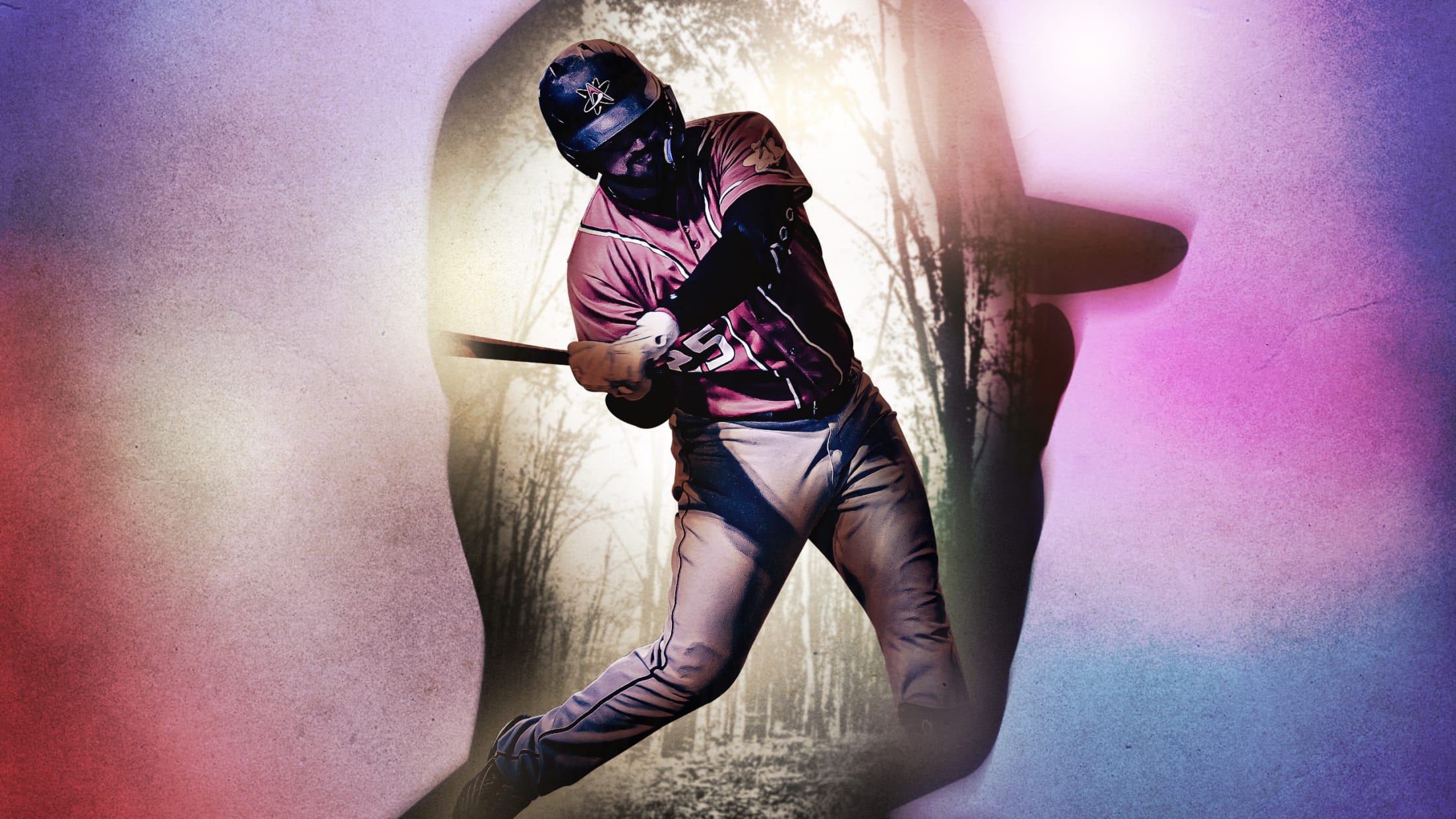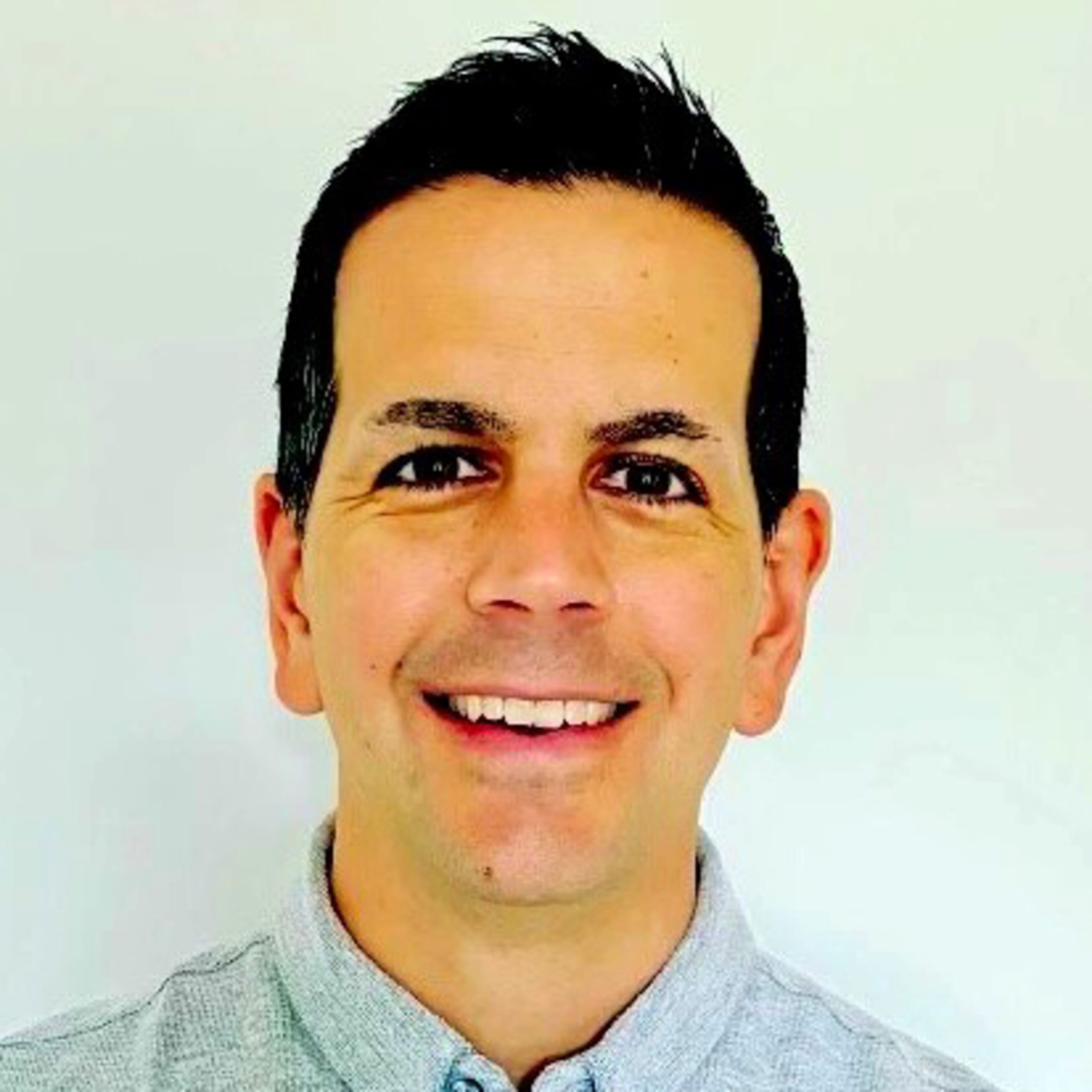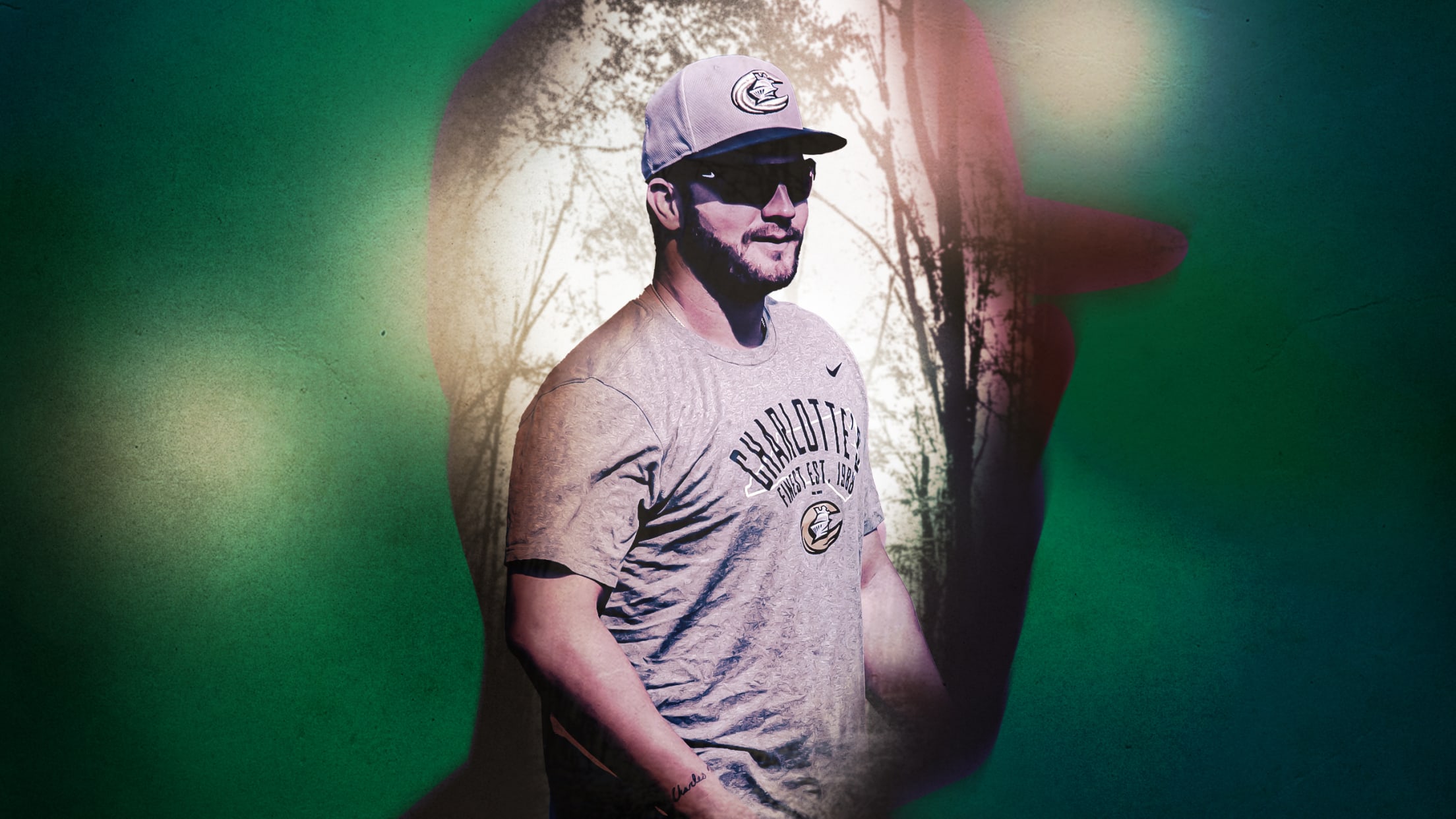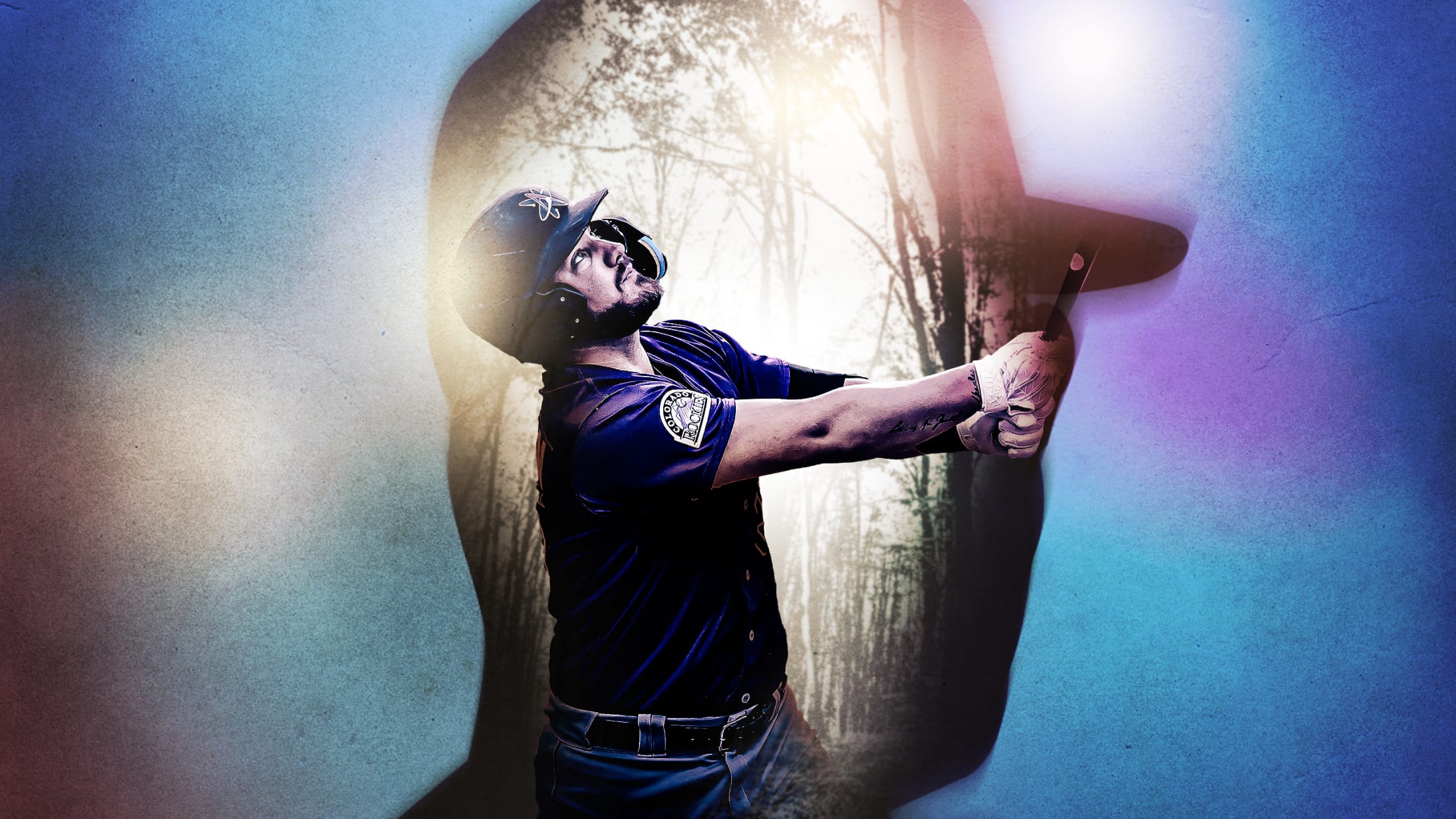
'He's not a bust. He's a rock star'

At first, when the fastball hit him in the face, D.J. Peterson didn’t feel the pain.
Rather than collapse to the ground, Peterson went into a crouch. He spit blood -- and one of his teeth -- to the ground. He was dazed, but his adrenaline had kicked in. Only later, after he had been carted to an ambulance and rushed to a hospital, did the agony and the severity of what had happened set in.
“I was crying,” he remembers, “thinking I was never going to play baseball again.”
It has been nine years since Peterson, then a promising young prospect fresh off a first-round selection in the amateur Draft, had his life and career dramatically altered by the hit by pitch that shattered his jaw and, ultimately, his confidence. In the time since, he has seen his prospect sheen fade while many of the players drafted just before and after him in 2013 have gone on to long careers in the big leagues.
But Peterson, who has spent the 2022 season as the first baseman for Triple-A Albuquerque in the Rockies’ system, is a professional baseball survivor of a different sort. While he might never get his call to the Majors, he has hard-earned perspective on the grind of the game and the importance of mental health that benefits not only himself but his teammates.
Some might look at the list of first-rounders from 2013 and label the now-30-year-old Peterson a “bust.” But his story is a reminder that -- in a game in which what happens between the ears affects so much of what happens between the lines -- to triumph over trauma is a remarkable achievement.
And that’s what D.J. Peterson has done.
“Every player has a different story,” says Albuquerque manager Warren Schaeffer. “His is not a smooth one, by any means. But it’s still alive and well.”

In the Mariners’ amateur scouting department, there was no doubt as to who the top two college hitters in the 2013 Draft class were: Kris Bryant and D.J. Peterson.
“We had guys who thought D.J. was as good as Bryant as a hitter,” says Tom McNamara, then the Mariners’ scouting director and now a special assistant to the general manager with the Royals. “Bryant did more things -- he ran better, and he played center field a couple games in college. But D.J. was right there. I remember we had him fifth or sixth on our Draft board.”
Three years earlier, the Mariners had drafted Peterson in the 33rd round out of Gilbert (Ariz.) High School, knowing they were longshots to actually sign him. Peterson had made a commitment to the University of New Mexico [UNM] and was only willing to break it if the Mariners met his signing bonus demand.
“There was a crosschecker, who is not in the game anymore, who texted me and said, ‘Good luck getting this amount of money coming out of UNM,’” Peterson recalls. “For me, that was motivation, that just lit the fire. Every single day I was [at UNM], I’m obviously there to get an education and help the team win, but I was also out to prove that guy wrong.”
He did.
In his three years with the Lobos, Peterson put up absurd offensive numbers, including a .408/.520/.807 slash with 18 homers and 25 doubles in 55 games his junior year. He also starred for USA Baseball’s 2012 Collegiate National Team. In a lineup that featured Bryant, Trea Turner, Michael Conforto and several other future big leaguers, Peterson led the team in home runs and RBIs.
“That,” he says, “is what solidified me being a first-rounder.”
The Mariners had the 13th pick in the Draft. They figured Peterson would be long gone by then and instead had their sights set on two California high schoolers -- outfielder Dominic Smith (who would get taken at No. 11 by the Mets) and California high school shortstop J.P. Crawford (who would get taken at No. 16 by the Phillies and then, as fate would have it, wind up with the M’s in a 2018 trade).
When Peterson fell, the Mariners were thrilled.
“We thought he was kinda like a Bob Horner type,” McNamara says. “Every time I saw him, he hit. He was short to the ball, had power and had a big league swing. We got to know him and his family well. We were excited.”
Peterson watched the Draft alongside his younger brother, Dustin, a high school shortstop who wound up getting selected by the Padres in the second round, just 37 picks after D.J.
In starting a professional career at the same time as his bro and receiving a $2.76 million signing bonus that a certain crosschecker had once said would never be possible, Peterson was living a dream. And at first, that dream played out perfectly. He reported to Single-A Everett (a short-season affiliate) and picked up right where he had left off with the Lobos, slashing .312/.382/.532 in 29 games to earn a quick promotion to Single-A Clinton, in Iowa.
“He went out and did exactly what we thought he was going to do,” McNamara recalls. “It was almost like, ‘We’re good here, let’s move on to next year.’”
But just 25 games into his time at Clinton -- less than two months into his professional career -- everything changed with a single pitch.
* * * * * * * *
I knew he had at least a mild concussion, because he kept asking the same three or four questions repeatedly. ‘Do you think I’ll ever be able to play again?’
Alvin Davis
It was Aug. 22, 2013. Peterson, a right-handed hitter, was down in the count, 0-1, in the third inning of a game against the Wisconsin Timber Rattlers. The pitcher on the mound was Jorge López -- the same López currently enjoying a breakthrough All-Star season in which he was recently dealt from the Orioles to the Twins.
In Peterson’s first at-bat, the right-handed López had thrown him all four-seamers and sliders. Anticipating another slider on the 0-1 pitch, Peterson leaned over the plate. When López surprisingly threw him a two-seamer, Peterson was caught completely off guard.
“I froze,” he says.
The pitch smacked him square in the left side of his jaw.
Peterson spit his tooth out on home plate. Clinton’s athletic trainer rushed to the scene. Peterson could not talk, could not move his mouth. Fortunately, in a crowd of very few people, there was a dentist on-hand. He, too, rushed to home plate, briefly examined Peterson and announced, “He needs to go to the hospital!”
So they put Peterson on a cart and then in an ambulance, which took him to the Mercy Medical Center, Clinton’s general hospital. X-rays were taken, and it was quickly determined that Peterson would need help that Clinton’s hospital could not provide. His jaw had been shattered, his gum punctured.
Alvin Davis, the former AL Rookie of the Year known as “Mr. Mariner,” just so happened to be in Clinton that day as a roving instructor. He rode to the medical center to be with Peterson.
“The doctor said what he was seeing was consistent with what he sees when people are in car accidents and hit the steering wheel or dashboard without a seatbelt,” Davis says. “That’s how serious it was.”
Peterson was loaded into another ambulance, this time for a 90-minute drive to the University of Iowa Hospital in Iowa City. Davis rode with him, praying over him.
“It was a long ride,” Davis says. “I knew he had at least a mild concussion, because he kept asking the same three or four questions repeatedly. ‘Do you think I’ll ever be able to play again?’ I tried my best to just keep him hopeful and to keep him awake, because he was drowsy from the trauma.”
Peterson was rushed to emergency surgery. His face was swollen and aching.
“My jaw was wired shut,” he says, “so that I couldn’t do any more damage to it.”
Then he was flown to Seattle, to see a craniofacial specialist who performed a six-hour surgery. And then another surgery. And then another.
“When they were putting my jaw together, it was like a puzzle. They have to put together all the broken parts and then put metal on the top to hold it in. [The specialist] didn’t like something the first time, so I had to go back in again. So it was three surgeries in three days, two in one day, and I wound up having six surgeries in all.”
Says McNamara: “I went to visit him. When I walked into the room, he was barely recognizable.”
For the next two months, Peterson’s jaw remained wired shut. Everything he ate was through a straw. He lost about 30 pounds.
“My mom would put spaghetti in a blender,” he says. “As gross as that sounds, that was my favorite meal, because it was as close to something solid that I could have.”
* * * * * * * *

Through it all, Peterson never stopped planning to play professional baseball.
By January of 2014, about five months after the hit by pitch, he was cleared to swing a bat. The following month, he reported to Spring Training camp in Peoria, Ariz. There, in a live batting practice session, he stepped into the box against an opposing pitcher -- organizational teammate Matt Anderson -- for the first time since that two-seamer struck him in the jaw and changed his life.
Anderson’s second pitch to Peterson was high and tight, up around the chin.
“Obviously accidental,” Peterson says. “But that kind of brought some flashbacks there.”
Before the incident in Iowa, Peterson had been the type of hitter unafraid to stand firm in the box and crowd the plate. It’s what allowed him to hammer sliders and offspeed pitches away. It’s what made him a first-round pick.
What happened in that first experience against live pitching upon his return, though, was a wake-up call, a signal that something material in his inner psyche had been altered. Peterson had never minded it much when pitchers ran one in on him and hit him in the arm, hit him in the leg, hit him in the back or buttocks. But you don’t endure six surgeries and who knows how many servings of blended spaghetti and come back exactly the same.
“A little self-doubt crept in,” he says. “I started thinking, ‘If a guy’s throwing in the upper 90s, am I really going to have a chance to get out of the way?’”
This is the fundamental truth about baseball that overwhelms any analytic: Once that doubt creeps in, you’re in trouble. Oh, sure, you might be able to fake it for a while, depending on the quality of your opponent. And for that 2014 season, Peterson did just that, slashing a solid .297/.360/.552 across the High-A and Double-A levels.
His sureness, though, had been replaced by skittishness. He feasted on fastballs early in the count. When he didn’t get them -- when the opposition pitched him inside -- he bailed in the box.
“If you look at High-A, it’s a lot of heaters, and the guys aren’t able to land a second or third pitch for a strike,” he says. “So if you can do a good job of just hitting a fastball that’s in the zone, you’re gonna do a lot of damage. But if you actually look at the numbers, I struck out well over 100 times that season [116, to be exact]. I knew, subconsciously, what was going on. But the year was so good that I was able to not talk about it and kind of get away with it.”
Peterson’s condition caught up with him in 2015. Playing almost a full season at Double-A Jackson, he batted a disappointing .224/.290/.346 with only seven homers and 90 strikeouts in 393 plate appearances.
The more at-bats Peterson compiled, the more opponents picked up on his jumpiness.
“You see it with guys sometimes, you can see in the batter’s box that there’s just a little hesitation,” McNamara says. “There might be a little drift on the backside. They’re just not in their legs like they usually are. There’s just something missing.”
In the rest of Peterson’s time with the Mariners, that something -- that special thing that had made the club so excited to draft him in such a prominent spot -- never returned. By the middle of the 2017 Minor League season, the Mariners had overhauled their front office, and Peterson had run out of allies and time. He was cut loose at Triple-A Tacoma, signed a Minor League deal with the White Sox for the remainder of 2017, the Reds for 2018 and the Sox again for 2019, playing at Triple-A each of those years. His numbers weren’t enough to earn a big league call, and when the Sox released him in June 2019, that very well could have been the end of Peterson’s baseball story.
* * * * * * * *
He’s not a bust. He’s a rock star.
Wayne Nance
When his struggles on the field had first compounded, Peterson would leave the apartment he shared with a teammate to be alone in his car, crying, feeling as though he had forgotten how to hit.
“As a kid, you're told, ‘Don't show your cards, be tough, don't let anyone see you weak,’” he says. “So I was stuck.”
But when his career was clearly on the brink, the wall Peterson had constructed broke down. He became honest about his condition with himself and his family. For the first time, he sought the help of a sports psychologist and opened up about his issues. And with nobody calling with an offer to play affiliated ball, he took an opportunity with the independent Sugar Land Skeeters for the remainder of the summer of 2019. For 37 games, he managed to turn off his brain and rake, batting .305/.380/.567.
“It was the best month and a half I had since the beginning of my professional career,” he says. “I just had fun and tore it up.”
He still didn’t get any calls from affiliated teams. And then the pandemic hit. Peterson played in the Skeeters’ abbreviated 2020 schedule but otherwise had to take up work at U-Haul just to get by. It gave him added appreciation for what it means to be a ballplayer.
“I knew I wasn’t ready for the desk,” he says. “Or the U-Haul.”
So while it was far from his first choice, Peterson signed up for another season of independent ball in 2021.
“I kept telling him, ‘Do you want to be an extra player on a Minor League team or play every day in the independent league?’” says McNamara, who has remained in touch with Peterson throughout his career. “Sometimes guys get better in those prime years, age 27-32. I kept telling him, ‘Put up numbers, and you’re going to garner interest.’”
So in 2021, Peterson put up numbers – first for the Lexington Legends of the Atlantic League, then the Cleburne Railroaders of the American Association. With a 1.171 OPS on the year, he strengthened his attractiveness to Major League teams while also strengthening his mental process.
Cleburne club set him up with a place to stay – a spare bedroom in the home of a man named Wayne Nance, an author who runs a business (Real Life Management) focused on improving clients’ health, money and relationships. Nance specializes in what he calls “sports attitude management,” as opposed to traditional sports psychology. It starts with a three-minute personality test Nance uses to evaluate his clients.
“If you focus on who athletes are at their core,” Nance says, “that tells me how they’re going to be at the plate, how they’re going to pitch on the mound, how they’ll respond if they make an error.”
Peterson talked with Nance about things bothering him on and off the field, going back to the injury.
“What D.J. wanted,” Nance says, “was a clarification of how his mind processes the sport. For example, he would get mad about bad calls by the umpire. I told D.J., ‘We’re going to do something different. When you’re in the on-deck circle, I want you to tell yourself you only have two strikes. If you get three, it’s a bonus.’”
That small trick of the brain helped Peterson perform better on the field. And in taking part in Nance’s attitude management training program, he developed the ability to help other players process and address their own problems.
“He was a victim of a fastball to the face,” Nance says. “I can tell you he’s on the other side of that now. He’s not a bust. He’s a rock star.”
* * * * * * * *

Independent ball is where many careers go to die. But Peterson’s performance revived him. It caught the attention of Rockies director of player development Chris Forbes, who, as a survivor of two brain tumors, lymphoma and a gunshot wound from a carjacking, has an incredible comeback story of his own. Forbes’ own experience gives him an appreciation for those who encounter and overcome struggle.
“I feel like adversity is an asset,” Forbes says. “Back when I was an area scout, you loved to find those guys with a chip on their shoulder that have been through some stuff. You take what D.J.’s been through, and he’s grateful for the opportunities he has. There are certain things you won’t worry about with him.”
Forbes offered Peterson a return to affiliated ball, via a Minor League contract for 2022. Peterson accepted and has proved an asset to the Isotopes, not only with his .281/.364/.543 slash line but with his leadership.
“I trust where I'm at the box,” he says. “I trust my positioning. I’m no longer skittish of sliders that start at me. I don't know what's going to be given to me tomorrow, so I'm going to enjoy today.”
Earlier this season, Mark Appel – the No. 1 pick of the 2013 Draft – made his long-awaited Major League debut, pitching an inning of relief for the Phillies. For the No. 13 pick from that Draft to also reach the big leagues this year might be a tall order. But those who have known him along the way are pulling for him -- especially the man who saw Peterson’s worst moment up close.
“I’m really, really proud of D.J., and I think him telling his story and being as transparent as he has been and being an advocate for mental health is important,” Davis says. “There’s still a lot of macho in the game, this idea that you’ve just got to be tough and work through things. To an extent, that’s probably true. But I think there are some situations not only on the field but off the field where you need help. You need somebody you can talk to and confide in.”
The path is never easy for a 30-year-old Minor Leaguer journeyman. On Aug. 9, the Rockies promoted first baseman Michael Toglia, one of their top prospects, to Triple-A -- a move that could eat into Peterson’s at-bats. But the Rockies just made another baseball lifer's dream come true as they called up Wynton Bernard after 863 Minor League games, proving that a big league career is possible as long as you're still out on the field.
But whether or not he ever gets his shot in the Majors, Peterson has proven himself a survivor of a vicious on-field injury. He’s married, with a young daughter. He has perspective that he hopes to utilize in a coaching role one day.
For now, he keeps suiting up for the Isotopes, keeps chasing that dream, keeps remembering what it was like to get hit in the face and to get back up.
“As long as I have a jersey on,” he says, “I have a chance.”